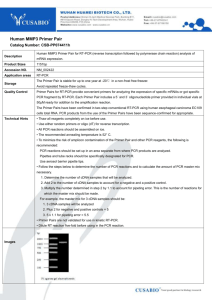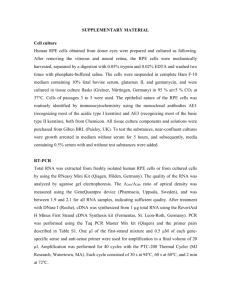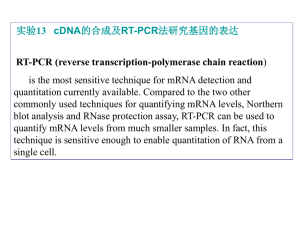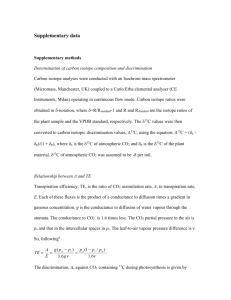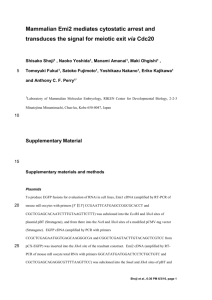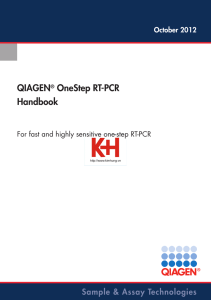Week 5 - Reverse Transcriptase Polymerase Chain
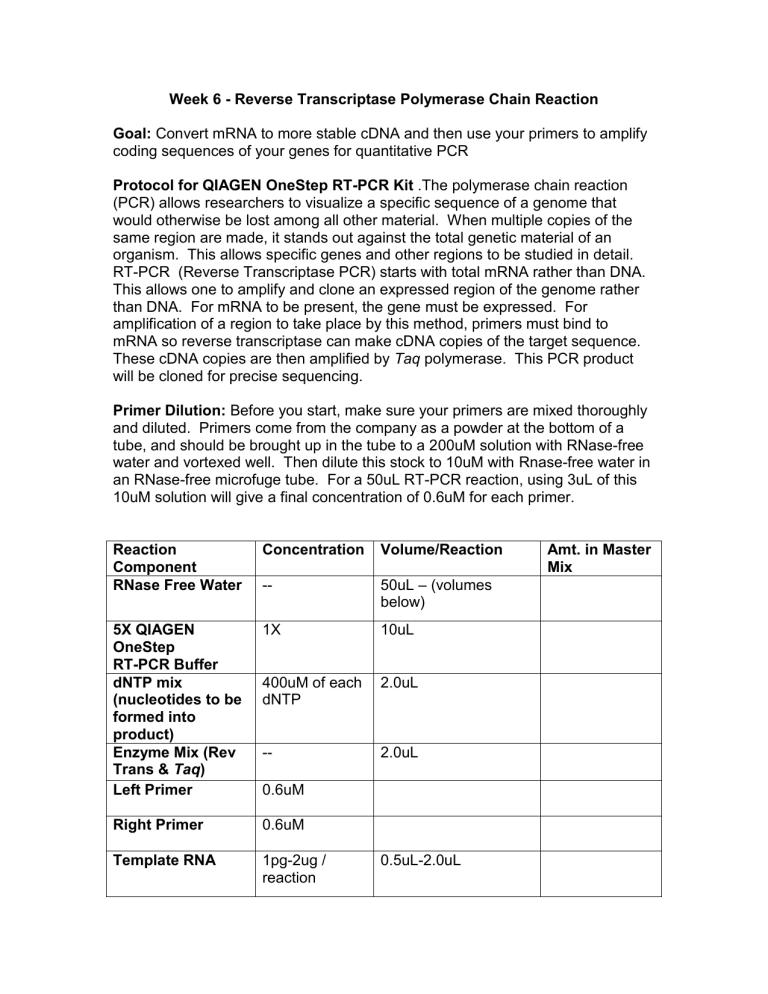
Week 6 - Reverse Transcriptase Polymerase Chain Reaction
Goal: Convert mRNA to more stable cDNA and then use your primers to amplify coding sequences of your genes for quantitative PCR
Protocol for QIAGEN OneStep RT-PCR Kit .The polymerase chain reaction
(PCR) allows researchers to visualize a specific sequence of a genome that would otherwise be lost among all other material. When multiple copies of the same region are made, it stands out against the total genetic material of an organism. This allows specific genes and other regions to be studied in detail.
RT-PCR (Reverse Transcriptase PCR) starts with total mRNA rather than DNA.
This allows one to amplify and clone an expressed region of the genome rather than DNA. For mRNA to be present, the gene must be expressed. For amplification of a region to take place by this method, primers must bind to mRNA so reverse transcriptase can make cDNA copies of the target sequence.
These cDNA copies are then amplified by Taq polymerase. This PCR product will be cloned for precise sequencing.
Primer Dilution: Before you start, make sure your primers are mixed thoroughly and diluted. Primers come from the company as a powder at the bottom of a tube, and should be brought up in the tube to a 200uM solution with RNase-free water and vortexed well. Then dilute this stock to 10uM with Rnase-free water in an RNase-free microfuge tube. For a 50uL RT-PCR reaction, using 3uL of this
10uM solution will give a final concentration of 0.6uM for each primer.
Concentration Volume/Reaction Reaction
Component
RNase Free Water -- 50uL
– (volumes below)
Amt. in Master
Mix
1X 10uL 5X QIAGEN
OneStep
RT-PCR Buffer dNTP mix
(nucleotides to be formed into product)
Enzyme Mix (Rev
Trans & Taq)
Left Primer
Right Primer
Template RNA
400uM of each dNTP
--
0.6uM
0.6uM
1pg-2ug / reaction
2.0uL
2.0uL
0.5uL-2.0uL
Using the table, calculate the amount of each reactant to add to your master mix.
To be safe, add enough reactant for one more reaction than you plan to run. For example, if you were planning for 4 reactions and adding 5X QIAGEN OneStep
RT-PCR Buffer, you would add 50uL to your master mix tube. Primer volumes should be calculated based on the dilution you prepared.
- Thaw reagents for the RT-PCR reaction, but be careful to keep RNA, primer dilutions, nucleotides and enzyme mix on ice.
- Prepare a Master Mix for your RT-PCR reaction in an RNase Free microfuge tube. This contains all components of the polymerase chain reaction but template mRNA.
-Mix the master mix gently (pipetting up and down is probably the best way), and aliquot the appropriate volume into small PCR reaction tubes. Your volume may vary, but will probably be between 48uL and 49.5uL, depending on your template
RNA volume.
-Add template mRNA to the individual PCR reaction tubes holding the master mix and gently mix reactants.
-Store tubes on ice while PCR machine warms up to 50 o C.
Programming the PCR machine for your RT-PCR reaction:
-Turn on the machine using the switch on the back and wait for the menu to appear
-Press F2 to program a new run. This step will tell the machine how long to stay at each temperature. The steps are:
1.Reverse transcription (mRNA
cDNA). This takes 30 minutes at 50 C
2. Initial PCR activation: HotStarTaq DNA polymerase is used in this kit, and must be activated by heating. This step is much warmer than the previous reverse transcription step. This step takes 15 minutes at 95C
3 Three-Step Cycling: Denaturation, Annealing, Extension. This cycle will occur
35 times in sequence, allowing for billions of copies of your region of interest to be produced. a. Denaturation: warm temperatures separate cDNA molecules, allowing for primer binding at 94C for 1 min b. Annealing: cooler temperatures allow primers to bind to cDNA template at 55C (about 5 degrees below your Tm) for 1 min c. Extension: a short period at this temperature lets the polymerase add bases from the primer at 72 C for 1 min
4. Final Extension Period at 72C for 10 min, followed by cooling to 4C until samples are placed in the freezer.
Temperature Cycles on an RT-PCR Reaction:
-PCR product should be stored at –20 o C until you are ready to run your gel next week.
Protocol adopted from QIAGEN OneStep RT-PCR Kit Handbook . QIAGEN.
Valencia, CA. May 2002.



